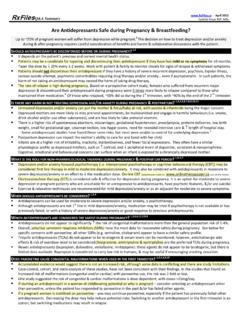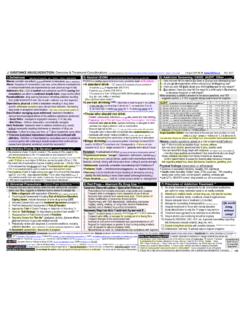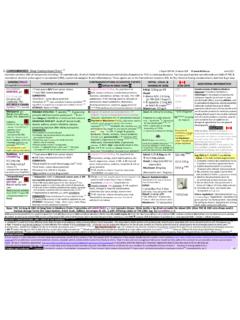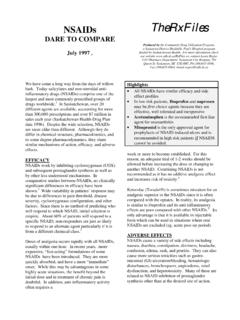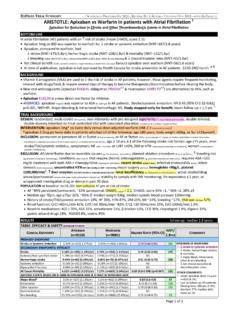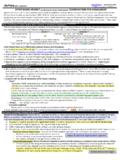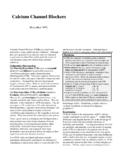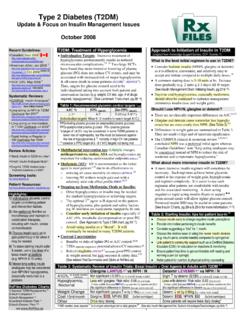Transcription of Topical Corticosteroids Newsletter - RxFiles
1 Produced by the Community Drug Utilization Program, a St. Paul's Hospital/Saskatoon District Health program funded by Saskatchewan more information check our website or contact us C/O Pharmacy Department, Saskatoon City Hospital701 Queen St., Saskatoon, SK S7K 0M7, Ph. (306) 655-8506, Fax. (306) 655-8804, Email: CorticosteroidsMay, 1998 iiiTopical Corticosteroids are widely used in the treatment ofinflammatory skin conditions. There are over 20 agents tochoose from, and an abundance of formulations. Optimaltherapy involves careful consideration of the disease s steroidresponsiveness, as well as the potency, formulation, applicationfrequency, and cost of the Topical SELECTION & USEP otency: Groups 1 7 Topical Corticosteroids are classified according to their relativepotencies. Seven potency categories (Group 1=Ultra highpotency and Group 7=Lowest potency) have been used anddescribed in Tables 3 and ,2 Higher potency agents exert agreater anti-inflammatory activity and carry a greater risk ofside effects.
2 Optimizing therapy involves choosing the agentwith the lowest potency, which will control the skin potency products are preferred on areas wherepenetration is high such as the groin, the axillae, and the are also recommended in young children, infants, and theelderly who are more prone to local and systemic side agents are usually preferred in patients who require longterm therapy or application to large potency agents are indicated in areas with chroniclesions (plaque psoriasis, lichen simplex, and discoid lupiserythematosus) and areas where skin penetration is poor (suchas the elbows, knees, palms, soles).3 After initial control isobtained, maintenance therapy with a lower potency agent isoften advisable. Occlusive dressings should be avoided whenusing Ultra-potent are more potent and effective than otherformulations due to their natural occlusive nature.
3 Ointmentsare generally preferable in dry, brittle, fissured, scaly, orhyperkeratinized skin areas. They are more effective in treatingchronic lesions (psoriasis). They should not be used in areassuch as the axilla, groin, or skin folds as their occlusive effectmay cause maceration, folliculitis and potential systemic Ointments are particularly useful in young childrenwith infantile atopic dermatitis where dryness of the skin is aparticular are often preferred for non-acute dermatoses as theyare cosmetically more acceptable. Proper application requires rubbing fully into the skin in such a way that a residue is notvisible after application. Some patients with chronicHighlights Topical Corticosteroids have been classified into 7potency groups: (Group 1 = Ultra High Potency, andGroup 7 = Lowest Potency).
4 Higher potency drugs are useful in more resistantconditions and thick skin areas. Caution should be takento minimize the potential for side effects. Lower potency drugs are generally preferred on thinskin areas, in young children & infants, and where longterm use is required. Many conditions can be managedwith low or mid potency agents. A step-down approach from higher to lower potencyagents, less frequent application, or to non-steroidemollients is often useful for maintenance therapy. Ointments cause more occlusion and are more effectivein dry & hyperkeratinized skin conditions. Relatively low-cost creams/ointments per potency groupUltra-High: Clobetasol propionate (Dermovate )High: Betamethasone dipropionate (Diprosone )Mid: Betamethasone valerate (Betaderm )Low: Hydrocortisone(Cortate )conditions may benefit from application of creams during theday, followed by ointments at night to maximize are non-greasy, non-occlusive, non-staining, and quickdrying.
5 They are most useful when applied to hairy or facialareas where residue from a vehicle is unacceptable. Caution iswarranted if used on the face as most products are are the least occlusive type of base. They are usefulwhen large skin areas or skin flexures are affected. They aremost useful in conditions where there is acute inflammation ortenderness such as acute contact Six ounces shouldcover the whole body of an average adult. Some lotions, suchas scalp lotions, are suitable for hairy Higher concentrations will increase thepotency, however, this effect seems to plateau. For example,increasing the concentration of hydrocortisone by a factor of 10results in an increase in potency by a factor of only Application to hydrated skin afterbathing can increase absorption by 4-5 Occlusion ( wrap) increases absorption by up to 10 Shortterm use of occlusion may be useful for severe lesions.
6 Ifplastic occlusion is used, a maximum of 12 hours in a 24 hourperiod is recommended to reduce the potential problems ofsweat retention, infection, and systemic side factors Various substances can enhance thepenetration and potency of Topical Corticosteroids . Forexample, while Diprosone and Diprolene both containbetamethasone dipropionate, the penetration of the drug isenhanced in an optimized base containing propylene glycolresulting in an Ultra-high potency product. Urea and salicylicacid also enhance the potency of a product and can beespecially useful in conditions such as SAFETYThe risk of side effects from Topical Corticosteroids is related todrug potency, duration of therapy, frequency of application andanatomical area. Common side effects are described in Table1. Dermal atrophy is one of the most notable local side may occur over several weeks, and is usually side effects such as HPA axis suppression are rare buthave been seen when the Ultra potent (Group 1) corticosteroidsare used.
7 Infants, children, and elderly are at higher the use of Ultra potent agents to a maximum of50g/week and a maximum duration of 2 weeks isrecommended. Rarely, Topical Corticosteroids may causeallergic reactions where the allergy is to the steroid itself. Inaddition, other ingredients ( lanolin, wool alcohols,parabens, antibiotics) in the product may be testing may be required to select an alternative product.(Common allergens included in Table 3 comparison.)Table 1 - Side effects of Topical Corticosteroids Skin atrophy: Usually occurs after several weeks of within 2 months (sometimes longer). Striae: Most common around the groin, axillae, and inner not reversible, although may fade over time. Telangiectasia: Visible distended capillaries. Often seen on theface, neck, chest. Usually reversible, but can be permanent.
8 Purpura: Bruising occurs with minimal trauma Fine hair growth: Reversible. Acneform/Rosacea like eruptions: Common on the face with highpotency agents. Reversible. Hypopigmentation: Especially in dark skinned people. Reversible. Infections: Symptoms of bacterial, fungal, and viral infections maybe masked. Conditions may worsen without being recognized. Rebound dermatitis: Can occur with sudden discontinuation. Systemic: ( Hypothalamic-pituitary axis suppression, Cushing ssyndrome, hyperglycemia, growth retardation in children).11 and elderly are at higher risk. Increased risk with Ultrapotent agents, or High potency agents on thin skin areas. Avoidusing more than 50g/week or longer than 2-4 weeks treatment withUltra potent FOR OPTIMAL PRESCRIBINGA pplication frequency - Topical Corticosteroids may beapplied from OD to QID.
9 For the initial management of acuteconditions, BID to QID application may be necessary. Lessfrequent dosing (OD-BID) is usually adequate for the morepotent agents. Since Corticosteroids penetrate slowly, the skinserves as a reservoir for the drug. Therefore, frequency ofapplication can often be reduced with repeated an acute condition is brought under control, OD to BIDdosing is often adequate for maintenance therapy andreduces the risk of side effects and Apply sparingly - Patient instructions ofteninclude Apply sparingly . It is important to apply just enoughto cover the affected area. Excess quantities are messy and awaste of money. As these products are well tolerated whenused appropriately, it is important that the instruction to Applysparingly does not convey the message that these products areextremely dangerous.
10 An excessive fear of topicalcorticosteroids may result in poor compliance, and sub-optimaltherapy. Before trying a second agent, potential non-compliance ( patient only using OD or PRN) should beassessed if initial therapy appears to (Tachyphylaxis) - Tolerance to the anti-inflammatory effects of Topical Corticosteroids can occur. Thisusually takes several weeks, but can occur earlier. Toleranceshould be suspected if an inflammatory skin condition worsensafter an initial good may be prevented by limiting long term applicationfrequency to once or twice daily. It is reversible and can bemanaged by stopping therapy for a few (~4) days, and thenresuming with the same or alternate Use of non-steroidbland emollients (See Table 6), following acute management offlare-ups, may also be a useful of Bases Mixing of bases, or adding ingredients canreduce the potency and shelf-life of some Antibiotic- corticosteroid CombinationsThere are few indications for antibiotic corticosteroidcombinations.
